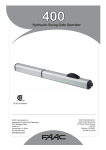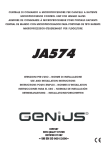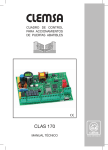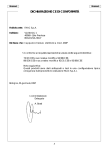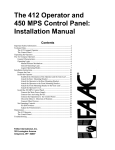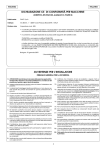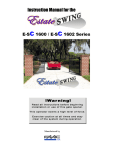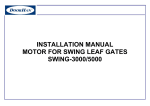Download FAAC Model 400 Series (English)
Transcript
455 D Control Board FAAC International Inc. Headquarter & East Coast Operations 5151 Sunbeam Road Suites 9-11 Jacksonville, FL 32257 Tel. 866 925 3222 www.faacusa.com FAAC International Inc. West Coast Operations 357 South Acacia Avenue Unit 357 Fullerton, CA 92831 Tel. 800 221 8278 CONTENTS 1. 455 D CONTROL BOARD 3 1.1 455 D Control Board Warnings3 1.2. Technical Specifications 3 1.3 Electric Connections 3 1.4. 455 D Layout and Components 3 1.5 Programming 7 1.6 Start-Up 9 1.7 System Test 10 2. OPERATING MODES DETAILED DESCRIPTION 11 3. PREWIRED ENCLOSURE DIAGRAM 13 4. POWER AND ACCESSORIES CONNECTIONS 14 AC Power Wiring Guidelines AC Power Connection Magnetic Lock Connection 14 14 14 LIMITED WARRANTY 15 Read this instruction manual before you begin installing the product. = Information regarding personal safety and proper maintanence of the product. = Information regarding the product’s characteristics or operation. 455 D Control Board - Rev: 01 - October 2010 455 D Contr ol Boa r d 2 1.4. 455 D Layout and Components 1. 455 D CONTROL BOARD 1.1 455 D Control Board Warnings F2 + – F F1 2 OP COM M1 4 5 OP COM M2 6 CL 7 8 LAMP J4 J1 9 10 11 12 13 14 15 16 17 18 19 20 21 A B OPEN STP CL OP FSW - - - + + +24V 22 23 24 25 Figure A -4°F to +131°F 2 (see Fig. A) Function Logics: Semi-automatic / Automatic / Safety Devices / “Stepped” Semi-automatic / “Stepped” Automatic / “Stepped” Safety Devices / Semi-automatic B / Dead-man C DL SIGNALLING AND PROGRAMMING DISPLAY Opening/Closing Time Programmable (from 0 to 120 s) Pause Time Programmable (from 0 to 4 min.) J2 CONNECTOR FOR RP RECEIVER Closing Leaf Delay Programmable (from 0 to 4 min.) Opening Leaf Delay 2 s (can be excluded) Thrust Force: LOCK -TX FSW W.L. FCC2 1 FCA2 MAIN L J6 J5 J6 J5 J1 J4 J3 J3 PE N Ambient Operating Temperature Range Protection Fuses F FCA1 15 VA – FCC1 0,5 A FCA2 F1 10 W Electric Lock Max. Load J2 J2 + Power Supply 115 V~ ± 10% or 230 V~ +6% -10% 50/60 Hz Accessories Max. Load FCC2 FSWCL 1.2. Technical Specifications 800 W FCC1 STOP OP_B Please refer to Chapter 16 for AC power wiring guidelines Motor Max. Load FCA1 OP_A Important: Before attempting any work on the control board (connections, maintenance), always turn off power. Absorbed Power DL FSWOP F2 J1 LOW VOLTAGE TERMINAL BLOCK J3 AC POWER SUPPLY TERMINAL BLOCK J4 MOTORS AND FLASHING LAMP CONNECTION TERMINAL BLOCK Adjustable on 50 levels for each motor J5 INDICATOR-LIGHT AND ELECTRIC LOCK TERMINALBLOCK Terminal Board Inputs: Open / Open Free Leaf / Stop / Limit-switch Opening Safety Devices / Closing Safety Devices / Power Supply + Earth. J6 LIMIT-SWITCH AND GATECODER TERMINAL BLOCK F1 MOTORS AND TRANSFORMER PRIMARY WINDING FUSE (F 5A - 230V) (F 10A - 115V) Terminal Board Outputs: Flashing Lamp / Motors / 24 VDC Accessories Power Supply / 24 VDC Indicator-Light / Fail Safe / 12 VAC Electric Lock Power Supply F2 LOW VOLTAGE AND ACCESSORIES FUSE (T 800mA) Programmable Functions: Logic / Pause Time / Thrust Force / Torque at Initial Thrust / Opening and Closing Leaf Delay / Reversing Stroke / Over-Pushing Stroke / Indicator-Light / Pre-Flashing / Electric Lock / Fail Safe / Safety Devices Logic / Assistance Request / Detection Time of Obstacle or Contact Point F “F” PROGRAMMING PUSH-BUTTON – “–” PROGRAMMING PUSH-BUTTON + “+” PROGRAMMING PUSH-BUTTON Learning Function: Simple or complete work time learning, with or without Limit-switch and/or Gatecoder. BLUE BLUE FCC2 1.3 Electric Connections VAC MAX. 60W 230 VAC 50 Hz or 115 VAC 60 Hz 24 V DC 3W OPEN A OPEN B STOP NB: Capacitors are supplied with the operator. 455 D Contr ol Boa r d For connection of the photocells and safety devices, see Section 13.4.1. 12 V AC LIMIT-SWITCH OR GATECODER Figure B 3 NOTE: All safety devices must be connected using NORMALLY CLOSED outputs. 1.4.1 Connection of Photocells and Safety Devices Before connecting the photocells (or other devices), it is advisable to select the type of operation according to the movement area they have to protect (see Fig.C): Opening Safety Devices: They operate only during the gate opening movement and, therefore, are suitable for protecting the area between the opening leaves and fixed obstacles (walls, etc) against the risk of impact and crushing. Opening/Closing Safety Devices Closing Safety Devices: They operate only during the gate closing movement and, therefore, they are suitable for protecting the closing area against the risk of impact. Opening/Closing Safety Devices: They operate during the gate opening and closing movements and, therefore, they are suitable for the opening and closing areas against the risk of impact. FAAC recommends use of the lay-out in Fig. D (in the event of fixed obstacles at opening) or in Fig. E (no fixed obstacles). N.B. If two or more devices have the same function (opening or closing), they should be connected to each other in series (see Fig. L). Connection of ONE Pair of Closing Photocells and ONE Pair of Opening/Closing Photocells (Recommended Layout) 9 10 11 12 13 14 15 16 17 18 19 20 21 B A OPEN STP CL OP FSW - - - RX CL Figure C STP CL OP FSW - - - + + +24V - 1 3 -TX FSW + + 2 4 - + 5 + TX OP/CL RX OP/CL 1 9 10 11 12 13 14 15 16 17 18 19 20 21 A B OPEN TX CL 2 - Connection of ONE Pair of Closing Photocells, ONE Pair of Opening Photocells and ONE Pair of Opening/Closing Photocells (Recommended Layout) LOCK -TX FSW W.L. 1 Opening Safety Devices Closing Safety Devices + + +24V LOCK -TX FSW W.L. 2 1 - -TX FSW + 3 2 + - - 4 + + 5 RX CL TX CL Figure E 1 2 - + 3 4 - - 1 + 2 -TX FSW + 5 + TX OP/CL 9 10 11 12 13 14 15 16 17 18 19 20 21 RX OP/CL B A OPEN 1 -TX FSW + 1 2 + 2 3 - 4 + 5 Connection of ONE Closing Safety Device and ONE Opening Safety Device STP CL OP FSW - - - + + +24V -TX FSW W.L. LOCK - + Figure F Connection of NO Safety Devices RX OP TX OP 1 2 3 - + Figure D 455 D Contr ol Boa r d 4 - - 1 + 2 -TX FSW + 9 10 11 12 13 14 15 16 17 18 19 20 21 B A OPEN STP CL OP FSW - - - + + +24V -TX FSW W.L. LOCK 5 + Figure G 4 Connection of TWO Pairs of Closing Photocells Connection of ONE Pair of Opening Photocells 9 10 11 12 13 14 15 16 17 18 19 20 21 9 10 11 12 13 14 15 16 17 18 19 20 21 B A OPEN CL OP FSW STP - - + + +24V - RX OP A B OPEN LOCK -TX FSW W.L. RX CL1 TX OP - - + + +24V LOCK -TX FSW W.L. TX CL1 2 2 - 1 3 -TX FSW + + 2 4 - + - 1 1 - STP CL OP FSW 5 + - + + 2 4 - + -TX FSW - 1 3 5 + Figure H TX CL2 RX CL2 1 Connection of ONE Pair of Closing Photocells -TX FSW + 1 2 + 9 10 11 12 13 14 15 16 17 18 19 20 21 B A OPEN CL OP FSW STP - - + + +24V - 2 3 - - 4 + + 5 LOCK -TX FSW W.L. Figure K RX CL TX CL 1 2 - 1 3 - + + + 2 4 - Connection of TWO N.C. Contacts in Series (e.g. Photocells, Stop) -TX FSW 5 + Figure I Figure L Connection of ONE Pair of Opening Photocells and ONE Pair of Closing Photocells Connection of TWO N.O. Contacts in Parallel (e.g. Open A, Open B) 9 10 11 12 13 14 15 16 17 18 19 20 21 B A OPEN STP CL OP FSW RX OP - - - + + +24V LOCK -TX FSW W.L. Figure M TX OP 1 2 - + 3 4 - - 1 + 2 -TX FSW + PE: N: L: 5 + TX CL RX CL + 1 2 + 2 3 - 4 + 5 Earth Connection / Ground AC V~ power supply (Neutral) AC V~ power supply (Line) NB: For correct operation, the board must be properly grounded. 1 -TX FSW 1.4.2 Terminal Block J3 - Power Supply (Fig. B) - + 1.4.3 Terminal Block J4 - Motors and Flashing Lamp M1: COM / OP / CL: Connection to Motor 1 Can be used in single-leaf configuration M2: COM / OP / CL: Connection to Motor 2 Cannot be used in single-leaf configurations Figure J 455 D Contr ol Boa r d LAMP: Flashing lamp output ( AC V ~) 5 1.4.4 Terminal Block J1 - Accessories (Fig. B) OPEN A - “Total Opening” Command (N.O.): Any pulse generator (push-button, detector, etc.) which, by closing a contact, commands opening and/or closing of both gate leaves. To install several full opening pulse generators, connect the N.O. contacts in parallel. OPEN B - “Partial Opening” Command (N.O.) / Closing: Any pulse generator (push-button, detector, etc.) which, by closing a contact, commands opening and/or closing of the leaf driven by motor M1. In the B and C logics, it always commands closing of both leaves. To install several partial opening pulse generators, connect the N.O. contacts in parallel. 1.4.6 Connector J2 - Rapid Connection to RP Receivers This is used for rapid connection to RP receivers (see Fig. Q). Connect the accessory with the components side facing the inside of the card. Insert and remove with power OFF. Figure Q STP - STOP Contact (N.C.): RP 1418 RP 433 RC Any device (e.g. a push-button) which, by opening a contact, is able to stop gate movement. To install several STOP devices, connect the N.C. contacts in series. NB: If STOP devices are not connected, jumper connect the STP terminals and -. CL FSW - Closing Safety Devices Contact (N.C.): 455 D The purpose of the closing safety devices is to protect the leaf movement area during closing. During closing, in the E-A-S-EP-AP-SP logics, the safety devices reverse the movement of the gate leaves, or stop and reverse the movement when they are released (see Advanced Programming in Section 13.5.2). During the closing cycle in logics B and C, they interrupt movement. They never operate during the opening cycle. If the closing safety devices operate when the gate is open, they prevent the leaf closing movement. NB: If no closing safety devices are connected, jumper connect terminals CL and -TX FSW (Fig. G). OP FSW - Opening safety devices contact (N.C.): The purpose of the opening safety devices is to protect the leaf movement area during opening. During opening, in the E-A-S-EP-AP-SP logics, the safety devices reverse the movement of the gate leaves. During the opening cycle in logics B and C, they interrupt movement. They never operate during the closing cycle. If the opening safety devices operate when the gate is closed, they prevent the leaf opening movement. NB: If no opening safety devices are connected, jumper connect inputs OP and -TX FSW (Fig. G). – - Negative for power supply to accessories + - 24 VDC - Positive for power supply to accessories Important: Accessories max. load is 500 mA. To calculate current draw, refer to the instructions for individual accessories. -TX FSW - Negative for power supply to photocell transmitters. If you use this terminal for connecting the negative for supplying power to the photocell transmitters, you may, if necessary, also use the FAIL SAFE function (see Advanced Programming in Section 13.5.2). If this function is enabled, the equipment checks operation of the photocells before each opening or closing cycle. 1.4.5 Terminal Block J5 - Indicator-Light and Electric Lock W.L. - Power supply to indicator-light Connect a 24 VDC - 3 W max. indicator-light, if necessary, between this terminal and the +24V supply. To avoid compromising correct operation of the system, do not exceed the indicated power. LOCK - Power supply to electric lock If necessary, connect a 12 VAC electric strike lock between this terminal and the +24V power supply. Please refer to Chapter 16 for Magnetic Lock connection. 455 D Contr ol Boa r d 6 1.5 Programming 1.4.7 Terminal Block J6 - Limit-Switch or Gatecoder These inputs are designed for connection of opening and closing limit-switches or Gatecoders The 400 operator cannot use limit switches but only Gatecoders. They are used to detect the leaf’s angular position and to thus obtain deceleration and stop positions more accurately than using the operating timing. Please refer to Figure S for wiring information. If the Gatecoders are not used the J6 inputs can be left unconnected. Figure S To program the 455D Control Board, you have to access “PROGRAMMING” mode. Programming is split into two parts: BASIC and ADVANCED. 1.5.1 Basic Programming To access BASIC PROGRAMMING, press key F: • Press and hold F, the unit will display the name of the first function / parameter. • When you release the key, the unit will display the parameter’s current value. • Value can be modified with keys + and - . • Press and hold F again, the unit will display the name of the next function / parameter. • When you reach the last function, press F to exit the program, the display resumes monitoring input status. FCC2 The following table displays the sequence of functions accessible in BASIC PROGRAMMING: BASIC PROGRAMMING Display press F Function Default OPERATING LOGICS (see tab. 3/a - h): RED = Semi-automatic = Automatic = “Safety” Automatic = “Stepped” Semi-automatic = “Stepped” Automatic = “Safety Stepped” Automatic = “B” Semi-automatic = Dead-man WHITE BLACK RED WHITE BLACK PAUSE TIME: 1.4.8 Operating Logics This is a brief description of the main operating logics of the system. For a complete description please refer to Table 3 • • • • • • A (automatic): The gate opens on command and automatically closes after a pause phase. A second command while opening is ignored; a second command during the pause phase interrupts the pause time; a second command during closing reopens the gate. A maintained open command will hold the gate open. S (security): The security mode is like A logic except that a second command during opening immediately closes the gate. A maintained open command will not hold the gate open. E (semi-automatic): This mode requires a second command during opening stops the gate. A second command during closing reopens the gate. EP (semi-automatic, step by step): This mode requires a command to open and a command to close. A second command during opening or closing causes the gate to stop. A third command then reverses the previous motion of the gate. B (manned, pulsed): This mode is designed for guard station use and requires a three button switch (pulsed) to open, close, and stop the gate. C (manned and constant): This mode requires constant pressure switches. One to open and one to close. No pressure on a switch stops the gate. This has effect only when automatic logic is selected. Adjustable from to secs. in one-second increments. Subsequently, display changes to minutes and tenths of seconds (separated by a decimal point), time is adjusted in 10-second increments, up to minutes max. Thus, if the unit displays , Pause Time is 2 mins. and 50 secs. LEAF 1 FORCE: Adjusts thrust of Motor 1. = minimum force = maximum force (hydraulic) LEAF 2 FORCE: Adjusts thrust of Motor 2. = minimum force = maximum force (hydraulic) LEAF 1 CLOSING DELAY: Delays closing start of leaf 1 with respect to leaf 2. Adjustable from to minutes (see Pause Time). TIME LEARNING (see Section F.3.): Enables the selection between “simple” (automatic) learning and “complete” (manual choice of deceleration and stop points) learning. Simple Learning: Complete Learning: + ≈ 1 s. + > 3 s. Exit from programming and return to inputs status monitoring. If using hydraulic operators, set force to maximum level. 455 D Contr ol Boa r d 7 Display 1.5.2 Advanced Programming To access ADVANCED PROGRAMMING, press and hold key F and then press key +: • Release key +, the unit displays the name of the first function. • Release key F, modify the value of the function with keys + and -. • Press and hold key F, the unit displays the name of the next function, and if you release it, the value that can be modified with keys + and -. • When you reach the last function, press F to exit the program, the unit resumes monitoring input status. The following table shows the sequence of functions accessible in ADVANCED PROGRAMMING: ADVANCED PROGRAMMING F Display + Function + Default Function If is selected, the output functions as a standard indicator-light (lighted at opening and pause, flashing at closing, and off when gate is closed). Different figures correspond to the extra time compared to normal work time (opening or closing) when the output can be used - via a relay - to power a courtesy light. Time can be adjusted from to sec. in 1 sec. steps, and from to min. in 10 sec. steps. = Standard indicator-light from to = Timed output CLOSING PHOTOCELLS REVERSE AT RELEASE: Enable this function if you want the closing photocells to stop movement and reverse at release. Default setting is immediate reverse. = Active = Disabled MAXIMUM TORQUE AT INITIAL THRUST: A.D.M.A.P. FUNCTION: The motors operate at maximum torque (ignoring the torque setting) at start of movement. Useful for heavy leaves. When enabled, the safety devices operate in compliance with French standard NFP 25/362. = Active = Disabled LAST STROKE AT CLOSING: The motors are activated at full speed for 1 second to facilitate locking of the electric lock. = Active =Disabled REVERSING STROKE: Before opening, while the gate is closed, the motors thrust to close for 2 seconds thus facilitating release of the electric lock. = Active = Disabled LEAF 2 OPENING DELAY (2 s): Enables delayed start (at opening) of leaf 2, avoiding interference between leaves. = Active = Disabled FAIL SAFE: If this function is activated, it enables a function test of the photocells before any gate movement. If the test fails (photocells not serviceable), the gate does not start the movement. = Active = Disabled PRE-FLASHING (5 s): Activates the flashing lamp for 5 seconds before start of movement. = Active = Disabled ELECTRIC LOCK ON LEAF 2: For using the electric lock on leaf 2 instead of on leaf 1. = Active = Disabled Default INDICATOR-LIGHT: = Active = Disabled ASSISTANCE REQUEST (combined with next function): If activated, at the end of countdown (settable with the next function i.e. “Cycle programming”) it affects 8 s of pre-flashing at every Open pulse (job request). Can be useful for setting scheduled maintenance jobs. = Active = Disabled CYCLE PROGRAMMING: For setting countdown of system operation cycles. Settable (in thousands) from to thousand cycles. The displayed value is updated as cycles proceed. This function can be used to check use of the board or to exploit the “Assistance request”. ANTI-CRUSHING SENSITIVITY: When operating with the gatecoder, it controls anti-crushing sensitivity. = Low = High. EXTRA WORK TIME: When operating without a gatecoder and limitswitch, if reversing occurs, and if the leaf does not reach its end contact point, you can activate this function to increase work time. = Active = Disabled Exit from programming and return to inputs status monitoring. NB: Parameter modifications take effect immediately. Exit out of programming to save changes. If the equipment is powered down before returning to normal status monitoring, any unsaved modifications will be lost. To restore programming defaults, press and hold the three buttons +, -, F simultaneously for 5 seconds. 455 D Contr ol Boa r d 8 1.6 Start-Up 1.6.3 Learning Operating Times Opening/closing time is established by a learning procedure which varies slightly according to whether you are using Gatecoders or not. 1.6.1 LED Check The board has a two-digit display. When not in “PROGRAMMING” mode, this display is used to indicate the status of inputs. Fig. U shows how the LED segments of the display exactly correspond to the inputs. 13.6.3.1 LEARNING NORMAL TIMES Normal learning (i.e. without limit-switches and Gatecoders) can be accomplished in two ways: - SIMPLE LEARNING (Without Slow Down): Check that the leaves are closed. Enter “BASIC PROGRAMMING,” select the TIME LEARNING function and then press the + pushbutton for 1 second. The display begins flashing and the leaves begin to open. As soon as the leaves reach the opening contact point, provide an OPEN A pulse (with the key operated push-button or with the radio control) to stop the movement. The leaves stop and the display stops flashing. Figure U The table below shows the status of the LEDs in relation to the status of the inputs. Note the following: LED ON = closed contact LED OFF = open contact Operation of the Status Signaling LEDs Press push-button F to exit and save the programming. The procedure is complete and the gate is ready to operate. - COMPLETE LEARNING (With Slow Down): Check that the leaves are closed. Enter “BASIC PROGRAMMING,” select the TIME LEARNING function and then press the + pushbutton for more than 3 seconds. The display begins flashing and leaf 1 begins to open. The following functions can be performed by sending OPEN A pulses (by key push-button or radio control): LEDs ON OFF OP_A Command activated Command inactive 1° OPEN - Slow down at opening of leaf 1 OP_B Command activated Command inactive STOP Command inactive Command activated 2° OPEN - Leaf 1 stops at opening and leaf 2 begins its opening movement FSWCL Safety devices clear Safety devices triggered FSWOP Safety devices clear Safety devices triggered FCA1 (if used) Flashes when Gatecoder 1 is in use FCC1 (if used) Flashes when Gatecoder 1 is in use FCC2 (if used) Flashes when Gatecoder 2 is in use FCA2 (if used) Flashes when Gatecoder 2 is in use The status of the LEDs while the gate is closed at rest are shown in bold. 1.6.2 Rotation Direction and Force Check 1. Program the functions of the 455 D control board according to need, as previously shown. 2. Cut power to the electronic control equipment. 3. Release the operators and manually move the gate to the mid-point of the opening angle. 4. Re-lock the operators. 5. Restore power. 6. Send and opening command on the OPEN A input (Fig.B) and check if the gate leaves are being commanded to open. N.B: If the first OPEN A pulse commands a closing, cut power and reverse the phases of the electric motor (red and black wires) on the 455 D control board. 7. Check force setting of the motors, modify if necessary (see Section 13.5.1). N.B: For hydraulic operators, like the 400, force should be programmed to maximum level (50) 8. Stop leaf movement with a STOP command. 9. Release the operators, close the leaves and re-lock the operators. Make sure travel limit mechanical stops are present. WARNING: During the learning procedure, safety devices are disabled! Avoid crossing the leaf movement area when this operation is carried out. 455 D Contr ol Boa r d 3° OPEN - Slow down at opening of leaf 2 4° OPEN - Leaf 2 stops at opening and immediately begins its closing movement 5° OPEN - Slow down at closing of leaf 2 6° OPEN - Leaf 2 stops at closing and leaf 1 begins its closing movement 7° OPEN - Slow down at closing of leaf 1 8° OPEN - Leaf 1 stops at closing When the display stops flashing, press push-button F to exit and save the programming. The procedure is complete and the gate is ready to operate. Notes: • If you wish to eliminate deceleration in certain stages, wait for the leaf to reach its stop-limit and supply 2 consecutive Open pulses (by 1 second). • If only one leaf is present, the entire sequence must nevertheless be effected. When the leaf has finished opening, supply 5 Open pulses until the leaf begins to close, and then resume normal operation. 1.6.4 Learning Times with Gatecoder Learning with the Gatecoder can be accomplished in two ways: - SIMPLE LEARNING (With Slow Down): Check that the leaves are closed. Access “BASIC PROGRAMMING,” select the TIME LEARNING function and then press the + push-button for 1 second: the display begins flashing and the leaves begin the opening movement. The movement stops automatically when the opening stop limit is reached. The display will stop flashing. Press push-button F to exit and save the programming. The procedure is complete and the gate is ready to operate, using the default slow down set at the factory. - COMPLETE LEARNING (With Slow Down): Check that the leaves are closed. Access “BASIC PROGRAMMING,” select the TIME LEARNING function and then press the + push-button for more than 3 seconds. The display begins flashing and leaf 1 begins to open. The following functions can be performed by sending OPEN A pulses (by radio control or key push-button): 9 1° OPEN -Leaf 1 slows down at opening (it stops automatically on reaching the stop limit) 2° OPEN -Leaf 2 opening movement begins 3° OPEN -Leaf 2 slows down at opening (it stops automatically on reaching the stop limit) 4° OPEN -Leaf 2 closing movement begins 5° OPEN - Leaf 2 slows down at closing (it stops automatically on reaching the stop limit) 6° OPEN - Leaf 1 closing movement begins 7° OPEN - Leaf 1 slows down at closing (it stops automatically on reaching the stop limit) 8° OPEN - End of learning When the display stops flashing, press push-button F to exit and save the programming. The procedure is complete and the gate is ready to operate. Notes: • The slow down pulse should be given before the gate reaches the positive stop to prevent the leaf from hitting it at full speed (it would be mistaken for an obstacle). • If only one leaf is present, the entire sequence must nevertheless be effected. When the leaf has finished opening, supply 5 Open pulses until the leaf begins to close, and then resume normal operation. 1.7 System Test When you are finished programming, test the system. Verify that the entire system operates correctly. Most importantly, check that force is adequately adjusted and that safety devices are operating correctly. 455 D Contr ol Boa r d 10 455 D Contr ol Boa r d S t o p s o p e r a t io n ( 3 ) C lo s e s t h e le a f ( w it h C lo s in g S a f e t y d e v ic e s e n g a g e d , o p e n s a t t h e 2 n d p u ls e ) ( 3 ) O P E N IN G LO C K ED N o e ffe c t (1 ) (3 ) C lo s e s t h e le a f ( 3 ) O P E N IN G LO C K ED Logic "EP" OPENING (always closes after a Stop) Restarts movement in reverse direction (3) Stops operation Stops operation (3) LOCKED opening time Opens leaf for the partial Re-closes the leaf immediately (3) Opens the leaf CLOSING OPEN CLOSED GATE STATUS OPEN-B C lo s e s t h e le a f ( 3 ) LO C K ED OPEN-A R e - c lo s e s t h e le a f im m e d ia t e ly ( 3 ) O P E N IN G Tab. 3/d R e - o p e n s t h e le a f im m e d ia t e ly C L O S IN G C LO SED R e - c lo s e s t h e le a f im m e d ia t e ly ( 3 ) O p e n s s in g le le a f a n d c lo s e s a f t e r p a u s e t im e O p e n s t h e le a f a n d c lo s e s it a f t e r p a u s e t im e O P E N o n PA U S E O PEN - B O PEN -A G A T E S TA T U S L o g ic " S " Tab. 3/c R e - o p e n s t h e le a f im m e d ia t e ly ( 1 ) C L O S IN G C LO SED R e lo a d s p a u s e t im e ( 1 ) ( 3 ) O p e n s s in g le le a f a n d c lo s e s a f t e r p a u s e t im e ( 1 ) O p e n s t h e le a f a n d c lo s e s it a f t e r p a u s e t im e ( 1 ) O P E N o n PA U S E O PEN - B O PEN -A G A T E S TA T U S L o g ic " A " Tab. 3/b R e - o p e n s t h e le a f im m e d ia t e ly C L O S IN G O p e n s s i n g l e l e af R e - c lo s e s t h e le a f im m e d ia t e ly ( 3 ) O p e n s t h e le a f C LO SED O PEN - B O PEN O PEN -A G A T E S TA T U S L o g ic " E " Tab. 3/a (OPEN disabled) No effect operation Stops STOP N o e ffe c t ( O P E N d is a b le d ) S to p s o p e r a t io n STO P N o e ffe c t ( O P E N d is a b le d ) S to p s o p e r a t io n STO P N o e ffe c t ( O P E N d is a b le d ) S to p s o p e r a t io n STO P PU LSES PU LSES PU LSES (if it must open, it disables OPEN) No effect see paragraph 5.2. No effect (saves OPEN) disabled) No effect (if on part.opng. OPEN A (OPEN disabled) No effect OPENING SAFETY DEVICES PULSES N o e ffe c t (if it must close, it disables OPEN) No effect No effect see paragraph 5.2. No effect (OPEN disabled) (3) No effect CLOSING SAFETY DEVICES No effect (OPEN disabled) opening Locks and, on release, continues open Locks and, on release, reverses to No effect (OPEN disabled) No effect (OPEN disabled) OP/CL SAFETY DEVICE N o e ffe c t O P E N d is a b le d ) L o c k s a n d , o n r e le a s e , c o n t in u e s o p e n in g N o e ffe c t (sa v e s O P E N ) R e v e r s e s t o c lo s e L o c k s a n d , o n r e le a s e , r e v e r s e s t o open s e e p a ra g ra p h 5 .2 . N o e ffe c t (sa v e s O P E N ) O n r e le a s e , c lo s e s a f t e r 5 " ( O P E N d is a b le d ) N o e ffe c t ( O P E N d is a b le d ) O P / C L S A F E T Y D E V IC E O n r e le a s e , c lo s e s a f t e r 5 " ( O P E N d is a b le d ) ( 3 ) N o e ffe c t C L O S IN G S A F E T Y D E V IC E S N o e ffe c t ( O P E N d is a b le d ) L o c k s a n d , o n r e le a s e , c o n t in u e s o p e n in g L o c k s a n d , o n r e le a s e , r e v e r s e s t o open R e lo a d s p a u s e t im e ( 1 ) ( O P E N d is a b le d ) N o e ffe c t ( O P E N d is a b le d ) O P / C L S A F E T Y D E V IC E N o e ffe c t ( O P E N d is a b le d ) L o c k s a n d , o n r e le a s e , c o n t in u e s o p e n in g N o e ffe c t ( if o n p a r t . o p n g . O P E N A d is a b le d ) N o e ffe c t ( O P E N d is a b le d ) N o e f f e ct s e e p a ra g ra p h 5 .2 . R e lo a d s p a u s e t im e ( 1 ) ( 3 ) N o e ffe c t C L O S IN G S A F E T Y D E V IC E S N o e ffe c t O P E N IN G S A F E T Y D E V IC E S R e v e r s e s t o c lo s e N o e ffe c t (sa v e s O P E N ) N o e ffe c t ( if o n p a r t . o p n g . O P E N A d is a b le d ) N o e ffe c t ( O P E N d is a b le d ) N o e f f e ct L o c k s a n d , o n r e le a s e , r e v e r s e s t o open N o e ffe c t ( O P E N d is a b le d ) N o e ffe c t (3 ) ( O P E N d is a b le d ) s e e p a ra g ra p h 5 .2 . N o e ffe c t ( O P E N d is a b le d ) O P / C L S A F E T Y D E V IC E N o e ffe c t C L O S IN G S A F E T Y D E V IC E S N o e ffe c t O P E N IN G S A F E T Y D E V IC E S R e v e r s e s t o c lo s e N o e ffe c t (sa v e s O P E N ) N o e ffe c t ( if o n p a r t . o p n g . O P E N A d is a b le d ) N o e ffe c t ( O P E N d is a b le d ) O P E N IN G S A F E T Y D E V IC E S 2. OPERATING MODES DETAILED DESCRIPTION (1) If maintained, it prolongs the pause until disabled by the command (timer function) (2) If a new pulse occurs within 2 seconds after reversing, it immediately stops operation. (3) During the partial opening cycle, an OPEN A pulse causes total opening. NB.: Effects on other active pulse inputs in brackets. 11 (1) If maintained, it prolongs the pause until disabled by the command (timer function) (2) If a new pulse occurs within 2 seconds after reversing, it immediately stops operation. (3) During the partial opening cycle, an OPEN A pulse causes total opening. NB.: Effects on other active pulse inputs in brackets. 455 D Contr ol Boa r d 12 S t o p s o p e r a t io n ( 3 ) C lo s e s t h e le a f ( w it h C lo s in g S a f e t y d e v ic e s e n g a g e d , o p e n s a t t h e 2 n d p u ls e ) ( 3 ) O P E N IN G LO C K ED C lo s e s t h e le a f ( 3 ) LO C K ED N o e ffe c t R e v e rs e s to o p e n N o e ffe c t O p e n s t h e le a f O PEN C L O S IN G O P E N IN G LO C K ED C lo s e s t h e le a f O p e n s t h e le a f N o e ffe c t ( O P E N - B d is a b le d ) S t o p s o p e r a t io n / C LO SED O PEN C L O S IN G O P E N IN G S t o p s o p e r a t ion / N o e ffe c t ( O P E N - A d is a b le d ) O P E N - B ( c lo s in g ) O P E N - A ( o p e n in g ) G A T E S TA T U S L o g ic " C " C l o s e s t h e l e af N o e f f e ct N o e f f e ct C l o s e s t h e l e af N o e f f e ct C O N T R O L S A LW AY S H E L D D O W N O p e n s t h e le a f C LO SED Tab. 3/h O P E N - A ( o p e n in g ) L o g ic " B " G A T E S TA T U S O P E N - B ( c lo s in g ) S t o p s o p e r a t io n ( 3 ) Tab. 3/g R e - o p e n s t h e le a f im m e d ia t e ly C L O S IN G O P E N IN G S t o p s o p e r a t io n ( 3 ) O p e n s s in g le le a f a n d c lo s e s a f t e r p a u s e t im e O p e n s t h e le a f a n d c lo s e s it a f t e r p a u s e t im e C LO SED O P E N o n PA U S E O PEN - B O PEN -A G A T E S TA T U S L o g ic " S P " Tab. 3/f R e - o p e n s t h e le a f im m e d ia t e ly C L O S IN G C LO SED S t o p s o p e r a t io n ( 3 ) O p e n s s in g le le a f a n d c lo s e s a f t e r p a u s e t im e O p e n s t h e le a f a n d c lo s e s it a f t e r p a u s e t im e O P E N o n PA U S E O PEN -B O PEN -A G A T E S TA T U S L o g ic " A P " Tab. 3/e S t o p s o p e r a t io n N o e ffe c t (O PEN -A /B disabled) STO P N o e ffe c t (O PEN A /B d isa b led ) S to p s o p e r a t io n N o e ffe c t (O P E N B d is a b le d ) STO P N o e ffe c t ( O P E N d is a b le d ) S to p s o p e r a t io n STO P N o e ffe c t ( O P E N d is a b le d ) S to p s o p e r a t io n STO P PU LSES PU LSES PU LSES N o e ffe c t ( O P E N B d is a b le d ) N o e ffe c t ( O P E N - A d is a b le d ) N o e ffe c t S t o p s o p e r a t io n ( O P E N - B d is a b le d ) N o e ffe c t N o e ffe c t N o e ffe c t ( O P E N B d is a b le d ) S t o p s o p e r a t io n ( O P E N - A d is a b le d ) N o e ffe c t ( O P E N A d is a b le d ) N o e ffe c t ( O P E N A d is a b le d ) C L O S IN G S A F E T Y D E V IC E S PU LSES N o e ffe c t N o e ffe c t (sa v e s O P E N A ) S t o p s o p e r a t io n ( O P E N - A d is a b le d ) O P E N IN G S A F E T Y D E V IC E S S t o p s o p e r a t io n ( O P E N - B d is a b le d ) N o e ffe c t N o e ffe c t C L O S IN G S A F E T Y D E V IC E S N o e ffe c t ( O P E N B d is a b le d ) N o e ffe c t ( O P E N A d is a b le d ) O P E N IN G S A F E T Y D E V IC E S S t o p s o p e r a t io n ( O P E N - A / B d is a b le d ) N o e ffe c t ( O P E N B d is a b le d ) N o e ffe c t ( O P E N A d is a b le d ) O P / C L S A F E T Y D E V IC E N o e ffe c t ( O P E N A / B d is a b le d ) S t o p s o p e r a t io n ( O P E N - A / B d is a b le d ) N o e ffe c t ( O P E N B d is a b le d ) N o e ffe c t ( O P E N A d is a b le d ) O P / C L S A F E T Y D E V IC E N o e ffe c t O P E N d is a b le d ) N o e ffe c t (sa v e s O P E N ) N o e ffe c t L o c k s a n d , o n r e le a s e , c o n t in u e s o p e n in g s e e p a ra g ra p h 5 .2 . R e v e r s e s t o c lo s e L o c k s a n d , o n r e le a s e , r e v e r s e s t o open O n r e le a s e , c lo s e s a f t e r 5 " ( O P E N d is a b le d ) ( 3 ) O n r e le a s e , c lo s e s a f t e r 5 " ( O P E N d is a b le d ) N o e ffe c t ( O P E N d is a b le d ) O P / C L S A F E T Y D E V IC E N o e ffe c t (sa v e s O P E N ) N o e ffe c t C L O S IN G S A F E T Y D E V IC E S N o e ffe c t ( O P E N d is a b le d ) L o c k s a n d , o n r e le a s e , c o n t in u e s o p e n in g L o c k s a n d , o n r e le a s e , r e v e r s e s t o open R e lo a d s p a u s e t im e ( O P E N d is a b le d ) N o e ffe c t ( O P E N d is a b le d ) O P / C L S A F E T Y D E V IC E N o e ffe c t ( if o n p a r t . o p n g . O P E N A d is a b le d ) N o e ffe c t ( O P E N d is a b le d ) N o e f f e ct s e e p a ra g ra p h 5 .2 . R e lo a d s p a u s e t im e ( 3 ) ( O P E N d is a b le d ) N o e ffe c t C L O S IN G S A F E T Y D E V IC E S N o e ffe c t O P E N IN G S A F E T Y D E V IC E S R e v e r s e s t o c lo s e N o e ffe c t (sa v e s O P E N ) N o e ffe c t ( if o n p a r t . o p n g . O P E N A d is a b le d ) N o e ffe c t ( O P E N d is a b le d ) O P E N IN G S A F E T Y D E V IC E S 3. PREWIRED ENCLOSURE DIAGRAM 455 D Contr ol Boa r d 13 4. POWER AND ACCESSORIES CONNECTIONS AC Power Wiring Guidelines 1. Check local wiring codes in all cases and follow all local building codes. Wiring and hookup should be performed by qualified electricians/installers only. Magnetic Lock Connection When connecting a magnetic lock to the system, use Maglock Relay Kit (P/N: 2352) and connect it as follows: 2. AC power should be supplied from a circuit breaker panel and must have its own dedicated circuit breaker. This supply must include a green ground conductor. 3. Properly ground the gate operator to minimize or prevent damage from power surges and/or lightning. Use a grounding rod if necessary. A surge suppressor is recommended for additional protection. AC Power Connection 1. Turn the circuit breaker for the AC gate operator power to OFF before connecting the AC input wires. 2. Turn the Power Switch located on the left side of the prewired enclosure to OFF before connecting the AC input wires. 3. Connect the AC input wires to the AC terminal located on the top left of the enclosure. See diagram on the right. 455 D Contr ol Boa r d 14 LIMITED WARRANTY To the original purchaser only: FAAC International, Inc., warrants, for twentyfour (24) months from the date of invoice, the gate operator systems and other related systems and equipment manufactured by FAAC S.p.A. and distributed by FAAC International, Inc., to be free from defects in material and workmanship under normal use and service for which it was intended provided it has been properly installed and operated. FAAC International, Inc.’s obligations under this warranty shall be limited to the repair or exchange of any part of parts manufactured by FAAC S.p.A. and distributed by FAAC International, Inc. Defective products must be returned to FAAC International, Inc., freight prepaid by purchaser, within the warranty period. Items returned will be repaired or replaced, at FAAC International, Inc.’s option, upon an examination of the product by FAAC International, Inc., which discloses, to the satisfaction of FAAC International, Inc., that the item is defective. FAAC International, Inc. will return the warranted item freight prepaid. The products manufactured by FAAC S.p.A. and distributed by FAAC International, Inc., are not warranted to meet the specific requirements, if any, of safety codes of any particular state, municipality, or other jurisdiction, and neither FAAC S.p.A. or FAAC International, Inc., assume any risk or liability whatsoever resulting from the use thereof, whether used singly or in combination with other machines or apparatus. Any products and parts not manufactured by FAAC S.p.A. and distributed by FAAC International, Inc., will carry only the warranty, if any, of the manufacturer. This warranty shall not apply to any products or parts thereof which have been repaired or altered, without FAAC International, Inc.’s written consent, outside of FAAC International, Inc.’s workshop, or altered in any way so as, in the judgment of FAAC International, Inc., to affect adversely the stability or reliability of the product(s) or has been subject to misuse, negligence, or accident, or has not been operated in accordance with FAAC International, Inc.’s or FAAC S.p.A.’s instructions or has been operated under conditions more severe than, or otherwise exceeding, those set forth in the specifications for such product(s). Neither FAAC S.p.A. nor FAAC International, Inc., shall be liable for any loss or damage whatsoever resulting, directly or indirectly, from the use or loss of use of the product(s). Without 455 D Contr ol Boa r d limiting the foregoing, this exclusion from liability embraces a purchaser’s expenses for downtime or for making up downtime, damages for which the purchaser may be liable to other persons, damages to property, and injury to or death of any persons. FAAC S.p.A. or FAAC International, Inc., neither assumes nor authorizes any person to assume for them any other liability in connection with the sale or use of the products of FAAC S.p.A. or FAAC International, Inc. The warranty herein above set forth shall not be deemed to cover maintenance parts, including, but not limited to, hydraulic oil, filters, or the like. No agreement to replace or repair shall constitute an admission by FAAC S.p.A. or FAAC International, Inc., of any legal responsibility to effect such replacement, to make such repair, or otherwise. This limited warranty extends only to wholesale customers who buy directly through FAAC International, Inc.’s normal distribution channels. FAAC International, Inc., does not warrant its products to end consumers. Consumers must inquire from their selling dealer as to the nature and extent of that dealer’s warranty, if any. This warranty is expressly in lieu of all other warranties expressed or implied including the warranties of merchantability and fitness for use. This warranty shall not apply to products or any part thereof which have been subject to accident, negligence, alteration, abuse, or misuse or if damage was due to improper installation or use of improper power source, or if damage was caused by fire, flood, lightning, electrical power surge, explosion, wind storm, hail, aircraft or vehicles, vandalism, riot or civil commotion, or acts of God. 15















